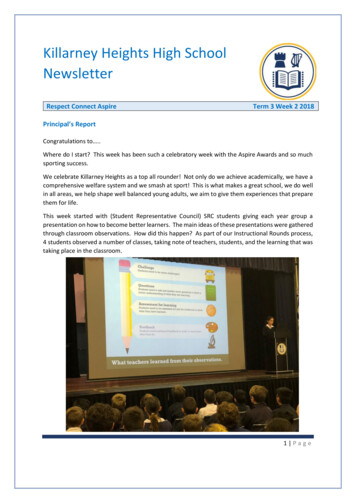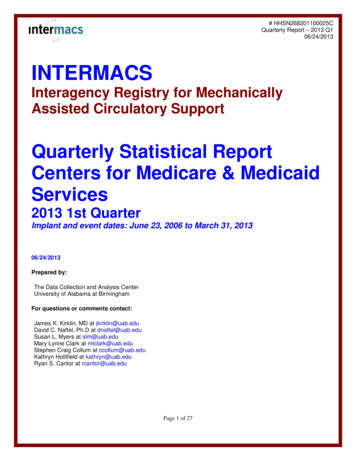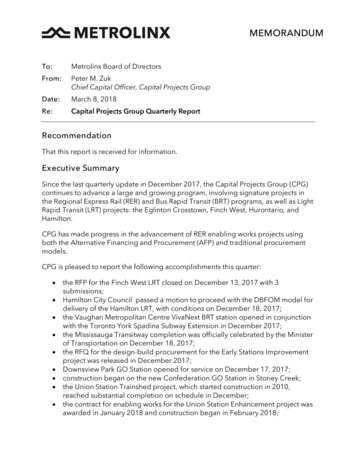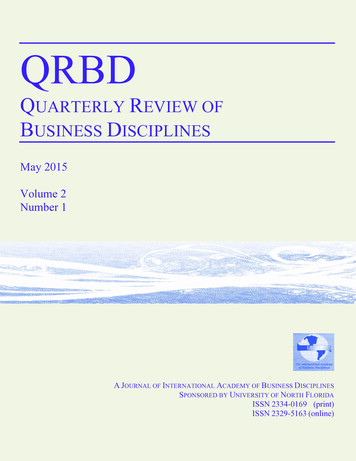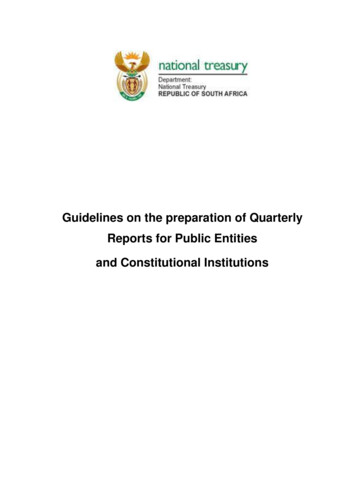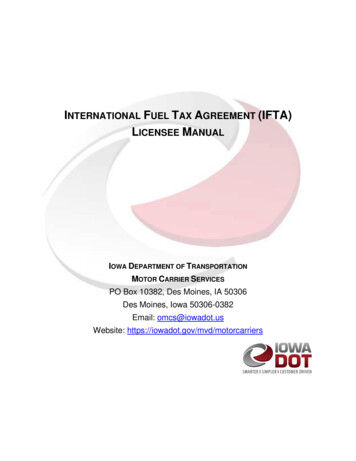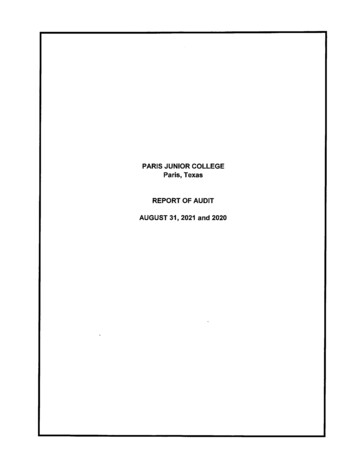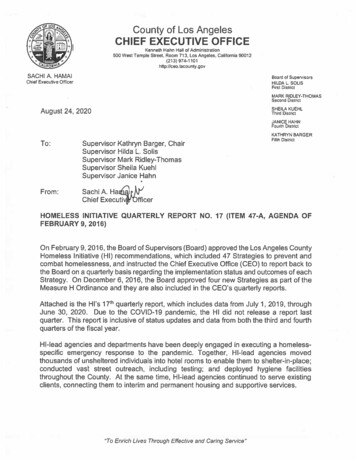
Transcription
QUARTERLY REPORT #17AUGUST 2020Hans Gutknecht Art
CONTENTSHOMELESS INITIATIVE: INTRODUCTION3HOMELESS INITIATIVE IMPLEMENTATIONHIGHLIGHTS4-7SUCCESS STORIES8 - 12PUBLIC ACCOUNTABILITYPERFORMANCE DATA & EXPENDITURES SUMMARYMEASURE H FUNDING RECOMMENDATIONS PROCESS131415MEASURE H CONTRACT DIRECTORY16AB 210 IMPLEMENTATION IN LA COUNTYLA COUNTY COVID-19 RESPONSE FOR PEOPLE EXPERIENCING HOMELESSNESS (PEH)LA COUNTY COVID-19 RESPONSE FOR PEH17PROJECT ROOMKEY18ACCESS TO HYGIENE STATIONS19MEDICAL SHELTERING20COVID-19 RECOVERY PLAN FOR PEH21OTHER KEY ACTIVITIESCITIES & COUNCILS OF GOVERNMENT UPDATE22CITY-LEVEL POINT-IN-TIME COUNT RRESULTS23EXHIBITS24QUARTERLY REPORT #17 – PUBLISHED AUGUST 20202
HOMELESS INITIATIVE: INTRODUCTIONMore than four years ago, the Los Angeles County Board of Supervisors madea bold move and created the County Homeless Initiative, which underscoredhomelessness as a top regional priority. With the creation of the HomelessInitiative and passage by voters of the landmark Measure H sales tax in March2017 – which is generating an estimated 355 million annually - we haveaccelerated our critical work to improve the lives of individuals and familiesexperiencing homelessness.While movements take time to build, thousands of individuals and families havealready been helped through a major expansion of outreach, emergency shelter,rapid rehousing, and permanent supportive housing for homeless disabled adults –in all parts of the County.This is a community-wide undertaking made possible only through sustainedcollaboration among dedicated service providers, County departments, civicleaders, cities, businesses, labor, faith-based institutions and community coalitions—and a galvanized public—who share the mission to prevent and combathomelessness in L.A. County.The Homeless Initiative’s 17th quarterly report includes 36 months of Measure H outcomes and shows that we are making measurableprogress across the full scope of the County’s commitment to combat and prevent homelessness. Although there was an increase in theCounty’s homeless population between 2018 and 2019, the increase was much smaller than the increase experienced by surroundingCounties, which can be directly attributed to Measure H.As the critical work continues, there is a powerful sense of community and commitment across Los Angeles County that, together, we canbring our homeless neighbors home and achieve lasting change.QUARTERLY REPORT #17 – PUBLISHED AUGUST 20203
HOMELESS INITIATIVE IMPLEMENTATIONOf the 51 HI Strategies approved by the Board, ALL have now been fully or partially implemented.Implementation status and next steps for the 51 HI strategies can be found in Exhibit I.23,692PERMANENTLY HOUSED THROUGHMEASURE H STRATEGIES SINCEJULY 2017PERMANENTLY HOUSED THROUGH MEASURE H STRATEGIESA total of 23,692 individuals and family members have been permanentlyhoused because of Measure H strategies since July 2017. Since July 2019, 8,509individuals and family members have been permanently housed throughstrategies funded by Measure H.A1 AND A5: HOMELESS PREVENTION PROGRAM FOR FAMILIESAND INDIVIDUALS1,452 new families were assisted with prevention services through the FamilySolutions Centers. During the same time period, 848 families exited the programand, of those, 661 (78 percent) either retained their housing or transitioned intoother permanent housing. In the same time period, 2,053 new individuals wereassisted in the Homeless Prevention Program for Individuals. Since July 2019,1,376 individuals exited the program and, of those, 992 (72 percent) eitherretained their housing or transitioned into other permanent housing.43,477PLACED ININTERIM HOUSINGFACILITIES THROUGH MEASURE HSTRATEGIES SINCEJULY 2017INTERIM HOUSING FUNDED IN WHOLE OR IN PART THROUGH MEASURE HSTRATEGIESA total of 43,477 individuals and family members entered interim housing funded in wholeor in part by Measure H since July 2017. Since July 2019, 14,005 individuals and familymembers entered interim housing funded in part or in whole by Measure H.*All highlights feature data for FY 2019-20 unless noted otherwise.QUARTERLY REPORT #17 – PUBLISHED AUGUST 20204
HOMELESS INITIATIVE IMPLEMENTATIONB3: PARTNER WITH CITIES TO EXPAND RAPID RE-HOUSING (RRH)5,903 RRH participants secured permanent housing with or without a RRH subsidy.Of RRH participants who secured housing with an RRH subsidy, 3,114 exited theprogram to permanent housing. These participants represent 86% of the 3,624participants who received an RRH subsidy and exited the program to anydestination.B4: FACILITATE UTILIZATION OF FEDERAL HOUSING SUBSIDIESThe participating Public Housing Authorities throughout the County provided 4,170,708 in incentives to landlords to help house 2,277 formerly homelessindividuals and families with housing vouchers.B7: INTERIM/BRIDGE HOUSING FOR THOSE EXITING INSTITUTIONS4,438 individuals discharged from institutions were provided interim housingadministered by DPH, DHS or LAHSA. Fifteen percent (488 out of 3354 total exits)exited to permanent housing.C4/C5/C6: ESTABLISH A COUNTYWIDE SSI AND VETERANSBENEFITS ADVOCACY PROGRAM FOR PEOPLE EXPERIENCINGHOMELESSNESS OR AT RISK OF HOMELESSNESSCountywide Benefits Entitlement Services Teams assisted 5,739 new disabledindividuals to begin pursuing applications for SSI and/or Veterans DisabilityBenefits.3,114PARTICIPANTS EXITED RRHINTO PERMANENTHOUSING THROUGH B34,438INDIVIDUALS RECEIVEDINTERIM HOUSING AFTEREXITING INSTITUTIONS5,739BEGAN PURSUING DISABILITYBENEFITS THROUGH C4/C5/C6*All highlights feature data for FY 2019-20 unless noted otherwise.QUARTERLY REPORT #17 – PUBLISHED AUGUST 20205
HOMELESS INITIATIVE IMPLEMENTATION1,223D2: EXPANSION OF JAIL IN-REACH1,223 inmates received D2 Jail In-Reach services.INMATES RECEIVED JAILIN-REACH SERVICESTHROUGH D22,495INDIVIDUALS PLACED INPERMANENT HOUSINGTHROUGH D7D6: CRIMINAL RECORD CLEARING PROJECTThe Public Defender (PD) held 108 record clearing services events and the City Attorney (CA) held 47 record clearingevents throughout the County. The PD engaged 736 clients and filed 1,292 petitions for dismissal or reduction. 537petitions filed by the PD (including some filed last FY) have been granted since July 2019. The CA engaged 995clients and filed 2,871 petitions for dismissal or reduction. 2,705 petitions filed by the CA have been granted since July2019.D7: PROVIDE SERVICES & RENTAL SUBSIDIES FORPERMANENT SUPPORTIVE HOUSING (PSH)3,175INDIVIDUALS LINKED TONEW ICMS SLOTSTHROUGH D73,175 clients were linked to new D7 Intensive Case Management Services(ICMS) slots. In the same time period, 1,885 additional participants who wereresiding in existing PSH units that had insufficient supportive services receivedD7 ICMS services to increase housing retention. 2,332 newly enrolled clientsreceived federal rental subsidies, 642 newly enrolled clients received localrental subsidies, and 2,495 clients were newly placed in D7 permanentsupportive housing.*All highlights feature data for FY 2019-20 unless noted otherwise.QUARTERLY REPORT #17 – PUBLISHED AUGUST 20206
HOMELESS INITIATIVE IMPLEMENTATIONE4: FIRST RESPONDERS TRAINING957 Los Angeles Sherriff’s Department (LASD) deputies andsergeants and 11 non-LASD law enforcement personnel,and 396 non-law enforcement first responders were trainedusing the LASD first responder training.E6: COUNTYWIDE OUTREACH SYSTEM14,005 individuals were newly engaged by Countywide OutreachTeams and 19,224 individuals were engaged by CountywideOutreach Teams (including some who had also been engaged inprevious reporting periods). Teams connected 15,419 individualsto services, placed 3,093 individuals into interim housing, andlinked 875 individuals to a permanent housing program.E8: ENHANCE THE EMERGENCY SHELTER SYSTEM2,404YOUTH ASSESSED USING THENEXT STEP TOOLE14: ENHANCED SERVICESTRANSITION AGE YOUTH (TAY)FOR2,404 youth were assessed using the NextStep Tool. 222 TAY exited TAY transitionalhousing to permanent housing, amounting to49 percent of all exits during that time period.12,539 individuals entered interim housing funded in whole or inpart by Measure H. During the same period of time, 3,656individuals exited interim housing to permanent housing,amounting to 33 percent of all exits from interim housing.*All highlights feature data for FY 2019-20 unless noted otherwise.QUARTERLY REPORT #17 – PUBLISHED AUGUST 20207
SUCCESS STORIESHaving Hope Leads Young Man to Stable HousingAn unstable and toxic home life made it difficult for Andre tograduate high school. Although he successfully obtained hisdiploma, the distraction of home life prevented him from applyingand going to college. Andre decided to leave home in search of abetter life for himself. He was homeless for 6 years in hishometown of Stockton, California before moving to Los Angeles,where he believed more resources would be available. Andrestruggled to find a job making more than minimum wage to affordrent and food. He began staying at emergency shelters until hecould get back on his feet.A housing navigator at St. Joseph’s Center was able to refer Andreto Jovenes, Inc., and he was soon connected to their HOST Homesprogram. Andre was matched and housed within two days to aHost community member who had a spare bedroom. Both Andreand the Host connected immediately upon meeting one another.The Host provided support for Andre’s educational goals by givinghim a laptop to do his college work and provided employmentopportunities. Through the stability of this program, Andre wasaccepted into Rapid Rehousing and is now looking for anapartment of his own.“I have gained stability through Jovenes, Inc. I have abeautiful place One of the words that pops into myhead is hope. This message is for those who lackhope, I want you to know that there is love and careout there and Jovenes, Inc is it.” - AndreStrategy E14: Enhanced Services for TAYQUARTERLY REPORT #17 – PUBLISHED AUGUST 20208
SUCCESS STORIESNational Health Foundation Provides Path toHousing for Homeless ManCarlos became homeless in 2011 after suffering severe injuriesfrom a major bike accident. The 61-year-old soon lost hisapartment and began living in his car. The constant moving andinstability made it hard for Carlos to maintain doctors’appointments.However, after being referred to the National Health Foundation(NHF) Reno Motel Recuperative Care, Carlos was finally able tosecure a bed of his own and much needed support in managing hishealth. NHF was able to provide Carlos with transportationassistance, weekly reminders of appointments and advocacy fortreatment by nursing staff. He was even able to receive eyesurgery at LAC USC to improve his eyesight.Carlos was eventually matched to permanent housing through St.Joseph’s Center.Strategy B7: Interim/Bridge Housing for those Exiting InstitutionsQUARTERLY REPORT #17 – PUBLISHED AUGUST 20209
SUCCESS STORIESWarm Welcome Home for Single MotherKrystal, a 26-year-old single mother of 3, previously lived with hergrandmother, where they helped one another to cover housingexpenses. Sadly, Krystal’s grandmother passed away in 2017, makingit hard for the single mother to afford the house on her own. Krystalsoon became homeless and began sleeping in shelters throughoutLos Angeles County.Through her connection with PATH, Krystal was able to obtain hotelvouchers and secure temporary shelter for herself and her children.In 2019, Krystal was matched with Koreatown Youth and CommunityCenter (KYCCC), a permanent supportive housing site provider.“It’s been a long time coming, but I’m just blessedthat me and my kids, especially my 3 girls, finally havea home again.”“The E-TSE Program offered me not away out, but rather an opportunity toregain control of my life to help myfamily. Without their assistance, there isno telling where we would be now.”Through collaboration between KYCCC and PATH, Krystal wassuccessfully matched to permanent housing at Menlo FamilyApartments in October 2019. KYCC also provided Krystal and herchildren with housewarming gifts to support their new journey andhome.Strategy D7: Provide Services & Rental Subsidies for Permanent Supportive HousingQUARTERLY REPORT #17 – PUBLISHED AUGUST 202010
SUCCESS STORIESChronically Homeless Man Gets Home of HisOwnMr. G had been chronically homeless for the past 15 years.Struggles with his mental health made it difficult for him tomaintain employment and he was eventually let go from hislast job in 2007. His mental illness impacted hisrelationships, which ultimately prevented him from stayingwith family. The 51-year-old soon found himself staying invacant parks, vans, and sometimes pooling money togetherwith friends to pay for a shared motel room.Mr. G was referred to the Countywide Benefits EntitlementServices Team (CBEST), where he was able to receiveassistance in applying for federal disability benefits. He wasalso referred to the Department of Health Services’ (DHS)housing program, to get placed in permanent housing. Withthe support of CBEST, Mr. G was approved for SSI and, soonafter, was able to secure an apartment.Strategy C4: Countywide SSI Advocacy Program for People Experiencing Homelessness or atRisk of HomelessnessQUARTERLY REPORT #17 – PUBLISHED AUGUST 202011
SUCCESS STORIESFrom the Riverbed, To a Permanent BedBradley, a 24-year-old transition- age youth, fell into homelessness after struggling with substance abuse issues.While living near the Los Angeles riverbed, he was engaged by Los Angeles Homeless Services Authorityoutreach workers, in collaboration with local law enforcement.The outreach workers started connecting Bradley to supportive services in an effort to address his mentalhealth concerns. Bradley was able to receive support from a PATH Multi-Disciplinary Team, Department ofMental Health HOME, and other clinical providers. He was also able to stay at a Project Roomkey hotel whileawaiting his transition into permanent housing. Bradley was matched to El Cielito Lindo, a permanent housingprogram with on-site supportive services. On June 25, 2020, Bradley signed a lease for permanent housing andnow plans to return to school and reconnect with his family.Strategy D7: Provide Services and Rental Subsidies for Permanent Supportive HousingQUARTERLY REPORT #17 – PUBLISHED AUGUST 202012
PUBLIC ACCOUNTABILITYPERFORMANCE DATAThe following exhibits provide cumulative performance datafor Fiscal Year 2019-20:EXHIBIT II – Outcomes for select HI strategy metrics, whichdemonstrate the significant progress most strategies have madesince the last quarterly report (includes FY 2017-18 and FY2018-19 data).EXHIBIT III – Data for Five Key Strategies by Service PlanningArea (SPA).EXHIBIT IV – Demographic information for individuals enrolledin, or served by, those same five key strategies, includinggraphs that provide a visual representation of the demographicdata.Additionally:Dashboards to track Measure H progress can be accessed using thefollowing link: http://homeless.lacounty.gov/impact-dashboard/A data visualization page highlighting key measures can be found RTERLY REPORT #17 – PUBLISHED AUGUST 202013
PUBLIC ACCOUNTABILITYAB210 Implementation in Los Angeles CountyAB 210, which took effect in January 2018, allows counties to create multidisciplinary teams (MDT) of service providers who canshare information that is otherwise confidential under State law/regulations to better and more quickly serve individuals andfamilies experiencing homelessness. The law enables homeless services providers, social service agencies, medical and mentalhealth personnel, and others to share such information for the purpose of improving coordination of housing and supportiveservices, increasing continuity of care, and decreasing duplication of services.While in the initial stage of AB 210 implementation, MDT members shared information “person-to-person,” the second stage ofimplementation offers enhanced information sharing tools. The County has developed a new automated information system,called the Countywide Homeless Information Portal (CHIP). CHIP queries information from various data source systems (CountyDepartment systems and the Los Angeles Homeless Services Authority’s Homeless Management Information System (HMIS)) andallows AB 210 MDT members to search and view homeless client service information. The CHIP now has approximately 360 userson the system. Additional users are being added on an on-going basis, as they complete required training and paperwork.In August 2020, the CHIP will have a new interface with the Department of Public Social Services’ (DPSS) Electronic DocumentManagement System (EDMS), which will allow the retrieval of identification documents, such as driver’s licenses, identificationcards, birth certificates, and passports. These documents are crucial to assisting clients with their applications for permanenthousing and supportive services.QUARTERLY REPORT #17 – PUBLISHED AUGUST 202014
PUBLIC ACCOUNTABILITYMeasure H Funding Recommendations ProcessIn September 2019, as directed by the Board of Supervisors, the Chief ExecutiveOffice – Homeless Initiative (CEO-HI) launched a process to develop Measure Hfunding recommendations for Fiscal Year 2020-21. As part of this process the CEO-HIhas completed the following activities designed to broadly share and gatherinformation from subject matter experts, key stakeholders, and the public: Convened eight policy summits to engage policy experts and key stakeholders; Facilitated, in collaboration with the Los Angeles Homeless Services Authority (LAHSA), eight community input sessions (one in eachService Planning Area), to engage community members; Solicited public comments from September 27 to November 30, 2019 through a publicized online form; Convened multiple meetings of HI Strategy lead agencies and County departments to discuss funding recommendations andconsider public input from the policy summits, community input sessions, and public comments gathered in the fall; Publicly released draft Measure H Funding Recommendations on June 26, 2020; Solicited another round of public comments following the release of the Draft Funding Recommendations through a publicizedonline forum; Held a public webinar to provide an overview of the Draft Funding Recommendations on July 1, 2020; and Convened a virtual public hearing to provide an opportunity for verbal public comment on July 8, CEO-HI.On September 15, 2020, final recommendations will be presented to the Board of Supervisors for consideration.Various materials from the RTERLY REPORT #17 – PUBLISHED AUGUST 202015at
PUBLIC ACCOUNTABILITYMEASURE H CONTRACT DIRECTORYThe FY 2019-20 Measure H-funded contract directory includes all Measure H-fundedcontracts, categorized by Homeless Initiative Strategy and by Service Planning Area,where applicable.The directory can be found online .pdfQUARTERLY REPORT #17 – PUBLISHED AUGUST 202016
LA COUNTY COVID-19 Response for PEHLos Angeles County COVID-19 Response for People Experiencing Homelessness (PEH)The County of Los Angeles is collaborating with the State, Los Angeles Homeless ServicesAuthority (LAHSA), City of LA, and other governmental and nongovernmental partners to preventand mitigate the impact of the novel coronavirus (COVID-19) on people experiencinghomelessness (PEH). Homeless individuals may be at an increased risk of contracting COVID-19and have fewer resources to protect themselves from contracting the disease.QUARTERLY REPORT #17 – PUBLISHED AUGUST 202017
LA COUNTY COVID-19 Response for PEHProject RoomkeyIn response to this pandemic, the County has partnered with the State on “Project Roomkey” (PRK) to enter into agreementswith hotels/motels to secure beds for people experiencing homelessness who are asymptomatic but are highly vulnerable tocomplications if they become infected with COVID-19 (those who are over 65 or have chronic health conditions). LAHSA, alongwith contracted homeless service providers, is managing the operations at these sites.Status of PRK as of July 28, 2020: The County and other jurisdictions within the County haveentered into agreements with 37 hotels/motels, generatingmore than 4,000 available beds for vulnerable PEH;More than 4,000 people experiencing homelessness have beenplaced in various hotel/motel locations.In addition, the County has identified and deployed Countyemployees acting as disaster service workers (DSWs) to staff thehotel sites and support other aspects of the COVID-19 PEHresponse. As of July 10, nearly 300 have already been activated.QUARTERLY REPORT #17 – PUBLISHED AUGUST 202018
LA COUNTY COVID-19 Response for PEHAccess to Hygiene StationsAdditionally, the County and the City of LAworked with LAHSA to deploy hygiene stationsthroughout the region. Nearly 400 handwashingstations and 10 toilet facilities have beendeployed throughout LA County. The County hasalso provided 400,000 in State emergencyfunding to Councils of Governments (COGs) toallocate to the cities to establish additionalhygiene opportunities for people experiencinghomelessness.QUARTERLY REPORT #17 – PUBLISHED AUGUST 202019
LA COUNTY COVID-19 Response for PEHMedical ShelteringThe County Emergency Operations Center (CEOC), which is the coordinating body for disaster response in the County, oversawthe logistics and operations of medical sheltering beds through June 30, 2020. The CEOC was able to bring 397 beds online,working closely with DPH, DHS, and other County and non-profit partners. These beds provide quarantine and isolation forindividuals who have tested positive for COVID-19, are experiencing symptoms, or may have had exposure to someone withCOVID-19. DHS took over oversight of the medical sheltering beds on July 1, 2020.More InformationFor up-to-date information on Los Angeles County’s COVID-19 response, including the response for people experiencinghomelessness, please visit: TERLY REPORT #17 – PUBLISHED AUGUST 202020
LA COUNTY COVID-19 Response for PEHCOVID-19 Recovery Plan for People Experiencing Homelessness (PEH)On the heels of the County’s emergency response to COVID-19 for PEH, during which temporary solutions to increase safety and limittransmission of COVID-19 were rapidly executed, on May 12, 2020, the Board of Supervisors directed LAHSA to develop a longer-termRecovery Plan. On June 23, 2020, LAHSA submitted a COVID-19 Recovery Plan to the Board, which focuses on the following key goals:1) No PEH housed through Project Roomkey or other COVID interim housing should return to the street;2) Rapidly house 15,000 of the most COVID-19 vulnerable people;3) Reduce inflow into homelessness;4) Prepare systems for future crises; and5) Ensure racial equity throughout implementation of the plan.The Recovery Plan is available at https://www.lahsa.org/documents?id 4579-lahsa-covid-19-recovery-plan-report.A key component of this plan includes utilizing one-time resources to launch a re-housing strategy. The Recovery Plan includes strategies to1) facilitate permanent housing solutions over a three-year period; and 2) significantly increase homeless prevention efforts, includingadvocacy to strengthen tenant protections to keep people in their homes. LAHSA has projected the COVID-19 Recovery Plan will cost a total 806.6 million over the next three fiscal years; 609.2 million of the total represents new costs over the three fiscal year period.On July 2, 2020, the Chief Executive Office submitted to the Board of Supervisors a County Funding Plan which identified 308.6 million inCounty-administered funding to support implementation of LAHSA’s Recovery Plan. The Funding Plan is available online athttp://file.lacounty.gov/SDSInter/bos/bc/1075135 leExperiencingHomelessness.pdf#search %22LAHSA%22.QUARTERLY REPORT #17 – PUBLISHED AUGUST 202021
OTHER KEY ACTIVITIESCITIES AND COUNCILS OF GOVERNMENTFunding for City Implementation PlansIn September 2018, the United Way of Greater Los Angeles’ Home For Good Funders Collaborativeissued a Request for Proposals (RFP) to bolster cities’ efforts to implement their Homelessness Plans.Approximately 8.2 million in Measure H Funds have been allocated for city-specific projects in twoareas: Priority Area 1: Increase the supply of supportive and interim housingPriority Area 2: Enhance the effectiveness of the homeless services delivery system23 agreements between the County and participating cities have been executed and 2 are in theprocess of being executed. On July 22, 2020, the CEO-HI notified the grantee cities that they mayrequest a no-cost extension for their contracts from February 28, 2021 to June 30, 2021.To supplement this funding for the city implementation grants, the Board of Supervisors allocated 6million in available Measure H carryover funds from FY 2018-19 to Councils of Government (COGs) tosupport activities that (a) align with the Board-approved, Homeless Initiative Action Plan to Prevent andCombat Homelessness and (b) are consistent with Priority Areas 1 and 2 for funding to supportimplementation of the city homelessness plans. Each COG conducted its own process to determinehow to utilize this funding consistent with these requirements. Funding is allocated in proportion toeach COG’s share of the 2019 Homeless Count and is available through June 30, 2021.For more information on artnershipwithcities,pleasegoto:QUARTERLY REPORT #17 – PUBLISHED AUGUST 202022
OTHER KEY ACTIVITIESCity-Level Point-in-Time Count DataAs part of the overall release of the 2020 Greater Los Angeles HomelessCount, LAHSA also released city ad community-level results. The Countprovides local data that guides cities and communities in their efforts tocombat homelessness. It is available at :https://www.lahsa.org/data?id 45-2020-homeless-count-bycommunity-cityQUARTERLY REPORT #17 – PUBLISHED AUGUST 202023
EXHIBITSEXHIBIT I:STATUS OF STRATEGIES TO COMBAT HOMELESSNESSEXHIBIT II:HOMELESS INITIATIVE PERFORMANCE DATA BY STRATEGYEXHIBIT III:SELECT HOMELESS INITIATIVE STRATEGY (B3, B7, D7, E6, E8)PERFORMANCE DATA BY SERVICE PLANNING AREA (SPA)EXHIBIT IV:DEMOGRAPHIC ENROLLMENT/SERVICE DATA FOR SELECTHOMELESS INITIATIVE STRATEGIESEXHIBIT V:BOARD MOTION RESPONSE SUMMARIESQUARTERLY REPORT #17 – PUBLISHED AUGUST 202024
EXHIBIT IHomeless Initiative Quarterly Report No. 17 – As of August 14, 2020Status of Strategies to Combat Homelessness(H) after Strategy Name indicates strategy is eligible to Measure H funding.Acronyms are spelled out in full at first mention; see appended chart for full list of acronyms.StrategyImplementation Date(Actual or Target)PREVENT HOMELESSNESSA1: Homeless PreventionProgram for Families (H)Actual Implementation Dates:Phase 1: May 2016Phase 2: November 2016Legal services for families atrisk of homelessness:March 2018Problem-Solving:October 2019A2: Discharge PlanningGuidelinesActual Implementation Date:June 2017A3: Housing AuthorityFamily Reunification ProgramPage 1StatusPrevention The Los Angeles Homeless Services Authority (LAHSA) developed an online trainingcurriculum to supplement the in-person 16-hour training about the COVID-19 Pandemic,which includes information on how to utilize the Problem-Solving intervention tool, andhow to request Problem-Solving Assistance Funds. LAHSA has implemented weekly office hours to provide ongoing technical assistanceand support to all individual, family, and TAY homeless services providers and keypartner staff who complete the online training curriculum. Problem-Solving and Prevention Scopes of Required Services have been modified andupdated.Next StepsPrevention LAHSA’s Prevention Unit will hosta kick-off virtual webinar toprovide support for preventionservice providers usingEmergency Solutions Grant (ESG)Funding.Problem Solving Implemented bi-monthly Peer Learning Groups to increase skill set of problem-solvers.Problem-Solving LAHSA’s Problem-Solving Unitwill develop a virtual series tosupport increasing the skills ofstaff utilizing the Problem-Solvingintervention.The Discharge Planning Guidelines, released in June 2017, continue to be available for useby institutions across the County.Distribute Guidelines as requested andrevise as needed. Los Angeles Sheriff’s Department (LASD) screened the following clients betweenJanuary 2020 and June 2020 for program eligibility. Participation is dependent uponLASD and Probation will continueto extend outreach efforts to
EXHIBIT Ireferred persons’ willingness to apply for services and eligibility for A3 services.Potential Program clients are referred to the Housing Authority of the City of LA’scontracted partner agencies:a. January: 121b. February: 77c. March: 130d. April:9e. May:48f. June:20Actual Implementation Date:March 2016identify supervised persons whocan qualify for and benefit fromthe Family Reunification Program. A4: Discharges from FosterCare and Juvenile ProbationActual Implementation Date:Phase 1: January 2018Phase 2: August 2018The Probation Department screened and referred the following probationers for programplacement between January and June 2020:a. January: 347b. February: 318c. March: 180d. April:73e. May:118f. June:85Department of Children and Family Services (DCFS) Approximately 257 Foster Care Exit questionnaires were mailed to former foster youthwho left care between January and May 2020. So far, of the total 257 surveys mailed, 36(14 percent) were returned with responses. Most respondents indicated that they areliving with a relative, had no housing concerns, and were able to secure a place to liveprior to exiti
D6: CRIMINAL RECORD CLEARING PROJECT The Public Defender (PD) held 108 record clearing services events and the City Attorney (CA) held 47 record clearing events throughout the County. The PD engaged 736 clients and filed 1,292 petitions for dismissal or reduction. 537 petitions filed by the PD (including some filed last FY) have been granted since July 2019.
